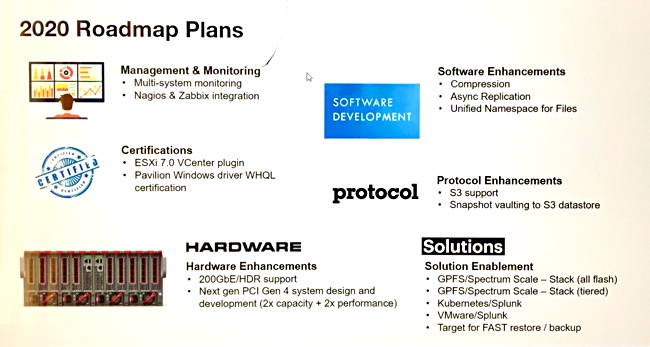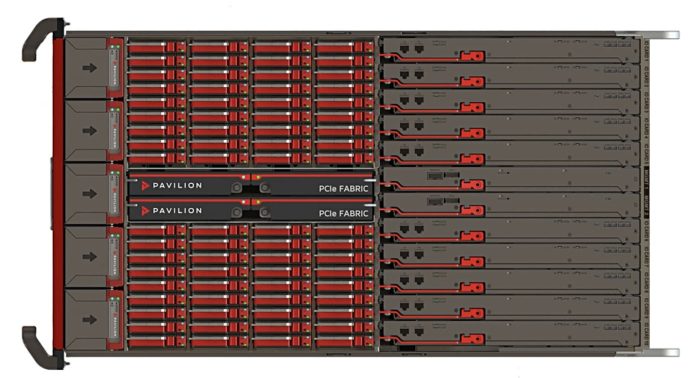Pavilion Data is developing a NVMe-oF flash array that is double the speed and capacity of its current line-up. The storage vendor also plans to release several software enhancements this year.
CEO Gurpreet Singh and his team briefed analysts this week about the current state of business and where the product roadmap is headed.
Pavilion Data Systems was founded in 2014 and has raised $58m to date in three rounds, including $25m most recently in 2019. Blocks & Files places Pavilion in a group with other NVMe-oF startups, including Apeiron, E8, Excelero and Kaminario. This group competes with mainstream NVMe-oF flash array suppliers such as Hitachi Vantara, NetApp and Pure Storage. It has reseller deals with Dell EMC, HPE and IBM, which also sell their own NVMe-oF all-flash arrays.
RF100 all-flash array
The San Jose startup has developed the RF100 all-flash array, which is built like a network switch with up to 10 controllers. This is a radically different approach from typical all-flash arrays which use the traditional dual-controller array architecture. Pavilion controllers are basically line cards and each contains four Ethernet ports – 40Gbit/s or 100Gbit/s.

The controllers are connected across an internal PCIe network to NVMe SSDs. This design means that it scales performance linearly. Each controller is implemented as a line card with 4 x 40Gbit/s or 100Gbit/s Ethernet ports. Host servers use NVMe-oF to access the RF100, and TCP and ROCE (RDMA) access is supported.
Customers can populate the array with SSDs they have purchased themselves, so existing supply deals can continue.
View from the Pavilion
Performance is Pavilion’s main selling point: the RF100 is fast, consistent and scales linearly. Claimed performance is up to 120GB/sec read bandwidth, 60GB/sec write bandwidth and 20 million 4K Random Read IOPS.
Pavilion claims world-record performance in four STAC-M3 analytical benchmarks against all other publicly disclosed systems, including systems with direct-attached SSD storage and Intel Optane drives. STAC members can get the details here.
Singh claims: “We’re the fastest storage system in the world [and] the need for speed is real.”

He thinks Pavilion has one of the largest NVMe-oF deployments in the world, with a US federal customer.
The company has a dual sales track, with some systems going to research labs such as the Texas Advanced Computing Centre, which need sheer consistent data access grunt. Other systems go to enterprises that need similar performance for applications such as media rendering farms and financial trading.
According to Singh, the company won several deals in the first quarter, including a $500K-plus deal last week with a global top five consumer electronics and media company. The customer will use Pavilion kit in an 4K and 8K video rendering farm.
Singh expressed confidence in the state of his business and with its partnerships with Dell EMC, HPE and IBM. He said sales cycles are elongating but not disappearing. At present, the company is modelling a two-quarter impact from the pandemic for enterprise customers and less impact on government and research business. Singh said Pavilion is not seeking fresh funding.
Roadmap
On the hardware front, Pavilion engineers are developing a PCIe gen 4-based system for 2021. PCIe gen 4 is twice as fast as the current PCIe gen 3 bus and the intent is that the upgrade will run twice as fast as the current hardware, with its average 40 microsecond access latency and 20 million IOPS. The system should also hold twice as much data, at 2PB effective capacity.

The IO ports will ramp up to 200Gbit Ethernet and InfiniBand capability, which is twice the current 100 gig speed.
Later this year Pavilion will introduce single pane of glass monitoring for multiple deployments and will support for open source Nagios and Zabbix network monitoring.

Pavilion’s roadmap includes a unified namespace for files across multiple systems, plus compression and asynchronous replication. Customers will get support for the S3 object access protocol and the ability to tier snapshots to S3 datastores.
Templates or reference architectures are going to be provided so partners can build all-flash or hybrid flash and disk Spectrum Scale systems. They also get recipes for Kubernetes-Splunk and VMware-Splunk systems.
Net:net
The mainstream NVMe-oF all flash array suppliers include Dell EMC, HPE, Hitachi Vantara, IBM, NetApp and Pure Storage. All position their NVMe-oF arrays as being the fastest arrays in their portfolio. Two, Dell EMC and IBM, have high-end, multi-controller or monolithic NVMe-oF arrays – the PowerMax from Dell EMC and the DS8800 from IBM. Multi-controller arrays are typically more powerful and scalable than dual-controller all-flash arrays, which all these suppliers have in their product lines.
NVMe-oF startups include Apeiron, Excelero, Kaminario and StorCentric’s Vexata.
Pavilion’s challenge is to distinguish itself from these competitors. They are all fast. The company needs its array to be faster, and is confident that its technology gives it the performance edge. Think of high end, monolithic NVME-oF performance at prices nearer dual-controller NVMe-oF arrays.
The company is leaning on this claimed performance superiority in its market messaging to try to stand out from the competition. We will monitor its progress with interest.








